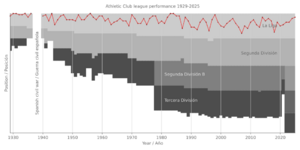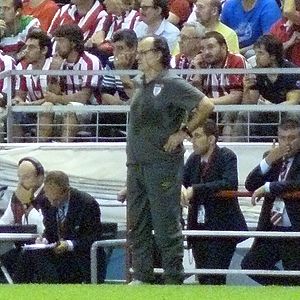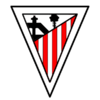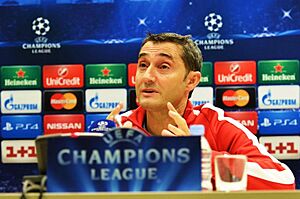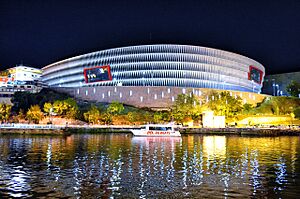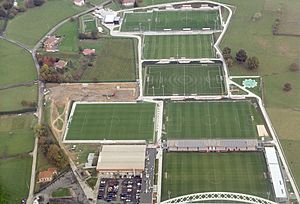Athletic Bilbao facts for kids
 |
|||
| Full name | Athletic Club | ||
|---|---|---|---|
| Nickname(s) | Lehoiak (The Lions) Zuri-Gorriak (The Red and Whites) |
||
| Founded | 18 July 1898 | ||
| Ground | Estadio San Mamés | ||
| Capacity | 53,289 | ||
| Coordinates | 43°15′51.0″N 2°56′57.7″W / 43.264167°N 2.949361°W | ||
| President | Jon Uriarte | ||
| Head coach | Ernesto Valverde | ||
| League | La Liga | ||
| 2022–23 | La Liga, 8th of 20 | ||
|
|
|||
Athletic Club, often called Athletic Bilbao, is a professional football team from Bilbao, Spain. They are known as Lehoiak (The Lions). This nickname comes from their stadium, San Mamés Stadium, which is near a church named after Saint Mammes of Caesarea. Saint Mammes was a Christian who, according to legend, was thrown to lions by the Romans but managed to calm them.
The team plays its home games at the San Mamés Stadium. Their home uniform is red and white striped shirts with black shorts. Athletic Bilbao is one of the most successful clubs in Spanish football. They have won eight La Liga titles, which is the fourth-highest number. They have also won the Copa del Rey 24 times, second only to Barcelona.
Athletic Bilbao is special because they are one of only three founding clubs of La Liga (Spain's top football league) that have never been relegated since the league started in 1929. The other two are Real Madrid and Barcelona.
A unique rule for Athletic Bilbao is their "cantera" policy. This means they only sign players who were born in or trained in football within the greater Basque Country. This area includes parts of Spain and France. This policy helps them develop local talent and build strong loyalty among players and fans.
Contents
- Club History
- How Athletic Club Started
- Early Success and Pichichi
- Fred Pentland and the "First Historic Attack"
- Telmo Zarra and the "Second Historic Attack"
- The Team of "Eleven Villagers"
- Iribar and the First UEFA Final
- Clemente's Success: League and Cup Winners
- The Fernández Era
- 21st Century Challenges and Triumphs
- Club Crest
- Players
- Coaching Staff
- Club Leadership
- Club Colors and Kits
- Club Achievements
- Stadium Information
- Lezama Training Facilities
- Club Rivalries
- See also
Club History
How Athletic Club Started
Football came to Bilbao in the late 1800s. It was brought by British workers and Basque students who had studied in Britain. Bilbao was an important industrial city, so many British workers lived there. They brought the game of football with them.
Basque students, like Juan Astorquia, also learned about football while studying in Britain. When they returned home, they started playing games with the British workers. These games took place at the Hippodrome of Lamiako.
In 1898, Juan Astorquia and other students began playing football regularly. In 1901, they decided to form an official club called Athletic Club. They used the English spelling for the name. In 1902, Athletic teamed up with another local club, Bilbao FC. They formed a combined team called Club Bizcaya. This team won the 1902 Copa de la Coronación, which was a very early version of the Copa del Rey. In 1903, Bilbao FC officially joined Athletic Club. The club considers 1898 as its founding year.
Early Success and Pichichi
Athletic Club quickly became very successful in the early Copa del Rey tournaments. After their win as Club Bizcaya, they won their first official Copa del Rey in 1903. They won again in 1910.
A very important player from this time was Pichichi. He was a fantastic goal scorer. He scored the first goal at the original San Mamés Stadium when it opened in 1913. He also scored three goals in the 1915 Copa del Rey final. Pichichi won his last Copa del Rey in 1921. Sadly, he passed away at just 29 years old in 1922. Today, the award for the top scorer in La Liga is called the Pichichi in his honor.
Fred Pentland and the "First Historic Attack"
In 1928, Athletic Club became one of the founding members of La Liga. In 1922, an English coach named Fred Pentland joined the club. He changed how Athletic played, focusing on short passes. He led the team to win the Copa del Rey in 1923.
Pentland returned to Athletic in 1929 and led them to amazing success. They won both La Liga and the Copa del Rey in 1930 and 1931. The club won the Copa del Rey four times in a row from 1930 to 1933. In 1931, Athletic beat Barcelona 12–1, which is still Barcelona's worst defeat and the biggest win in La Liga history.
Another English coach, William Garbutt, continued this success. He led Athletic to win the La Liga title in 1936. This team had a famous group of forwards known as the Primera delantera histórica (First historic attack). Key players included Bata, who was La Liga's top scorer in 1930–31, and Guillermo Gorostiza. Football stopped in Spain in July 1936 because of the Spanish Civil War.
Telmo Zarra and the "Second Historic Attack"
In 1941, the club's name was changed to Atlético Bilbao by a government rule. After the Civil War, the team had to rebuild. They focused on finding talented young players from the Basque region.
In the 1940s and early 1950s, a new group of legendary forwards emerged. They were called the Segunda delantera histórica (Second historic attack). This group included Rafa Iriondo, Francisco Gárate, Telmo Zarra, José Luis Panizo, and Agustín Gaínza. This team, coached by Juan Urkizu, won both the league and cup in 1943. They also won the Copa del Generalísimo (the cup's name at the time) in 1944 and 1945.
The biggest star of this era was Telmo Zarra. He became one of the club's greatest legends and its all-time top scorer with 335 goals. He won the Pichichi Trophy six times, a record only beaten by Lionel Messi much later. His 38 goals in the 1950–51 season was a record for 60 years. Zarra was also the top Spanish scorer in La Liga history for many years.
The Team of "Eleven Villagers"
In 1954, coach Ferdinand Daučík brought in new players. This new team won the league and cup double in 1956. They also won the Copa del Generalísimo in 1955 and 1958. The 1958 cup win is very famous. Athletic beat Di Stefano's Real Madrid 2–0 in Real Madrid's own stadium.
After this victory, the club president, Enrique Guzmán, famously said, "With eleven villagers, we have beaten them!" This phrase led to the team being remembered as el equipo de los once aldeanos (the team of eleven villagers). It highlighted the club's tradition of playing only with local Basque players.
In the same year, Athletic also played in the European Cup for the first time. They reached the quarterfinals, beating strong teams like FC Porto and Ferenc Puskás's Honvéd FC.
Iribar and the First UEFA Final
The 1960s were mostly dominated by Real Madrid. During this time, goalkeeper José Ángel Iribar became a huge star for Athletic. Fans would often say, Juegan Iribar y diez más (Iribar and ten others are playing), showing how important he was.
In 1969, Athletic won another Copa del Generalísimo. Key players from this period included Iribar, the goal scorer Fidel Uriarte, and winger Txetxu Rojo.
In December 1976, before a game, Iribar and Real Sociedad's captain publicly displayed the Ikurriña (the Basque flag). This was a very important moment, as it was the first time the flag was shown publicly since the death of Francisco Franco. After Franco's rule ended, the club changed its name back to Athletic.
In 1977, the club reached the final of the UEFA Cup (now the UEFA Europa League). They lost to Juventus on away goals. They also reached the Copa del Rey final but lost on penalties. Despite these losses, this team is remembered as one of Athletic Bilbao's best. It included famous players like Iribar, Rojo, Goikoetxea, and Dani.
Clemente's Success: League and Cup Winners
In 1981, Javier Clemente became the manager. He built one of the most successful teams in the club's history. In the 1982–83 season, Athletic won the La Liga title. The next year, they won both La Liga and the Copa del Rey. In that cup final, they beat Maradona's Barcelona 1–0. The match was very intense and ended with a fight between the two teams.
Athletic finished third in 1985 and fourth in 1986. Clemente was later fired due to disagreements with a star player. After him, several coaches tried to bring back the success, but it was difficult.
The Fernández Era
In 1998, coach Luis Fernández led the club to finish second in La Liga. This meant they qualified for the UEFA Champions League. Fernández's team included important players like Joseba Etxeberria, Ismael Urzaiz, and Julen Guerrero.
21st Century Challenges and Triumphs
Athletic Bilbao faced tough times in the mid-2000s, almost getting relegated in 2006 and 2007. However, in the 2009 Copa del Rey, they reached their first final in 24 years, but lost to Barcelona.
Before the 2011–12 season, a new president, Josu Urrutia, hired coach Marcelo Bielsa. Under Bielsa, Athletic reached their first European final since 1977, the 2012 UEFA Europa League Final, but lost to Atlético Madrid. They also reached the 2012 Copa del Rey Final but lost to Barcelona again.
After Bielsa, Ernesto Valverde returned as manager. In 2014, Athletic finished fourth in the league, which meant they qualified for the UEFA Champions League.
In 2015, Athletic reached the 2015 Copa del Rey Final but lost to Barcelona. However, they soon won their first trophy since 1984! In the 2015 Supercopa de España, Athletic defeated Barcelona 4–0 in the first game, with Aritz Aduriz scoring three goals. They drew 1–1 in the second game to win the Supercopa. Aduriz was a fantastic scorer, getting 36 goals that season.
Valverde left in 2017, and José Ángel Ziganda took over, followed by Eduardo Berizzo. Neither had much success. Then, B-team coach Gaizka Garitano took charge and improved the team's results.
In the 2019–20 season, Athletic had a strong start. They reached the Copa del Rey final against their rivals Real Sociedad. This final was postponed due to the COVID-19 pandemic and was eventually played in April 2021 without fans. Athletic lost 1–0.
By then, Marcelino had become coach. Athletic won the 2020–21 Supercopa de España in January 2021, beating Real Madrid and Barcelona. They also reached another Copa del Rey final in April 2021, but lost to Barcelona 4–0.
In the 2023–24 season, Athletic Bilbao ended their 40-year wait for a Copa del Rey title. They won the 2023-24 Copa del Rey by beating RCD Mallorca 4–2 on penalties after a 1–1 draw. This campaign included big wins against Barcelona and Atlético Madrid.
Club Crest
Athletic's club crest combines symbols from Bilbao and Biscay. It features the bridge and the church of San Anton from Bilbao's shield. The wolves on the crest come from the powerful House of Haro family, who founded Bilbao. From the Biscay shield, it includes the Gernikako Arbola (Guernica's tree) and the Cross of Burgundy. The first known use of this design was in 1922.
The club's first official crest was a blue circle with the letters A and C in white. Later, in 1910, they used a red-and-white flag with the club's initials. The first version of the current shield, with red-and-white stripes and local symbols, appeared in 1922. In 1941, during a time when non-Spanish names were not allowed, the crest used the name "Atlético Bilbao." In 1972, the club added full color to the design and brought back the original "Athletic Club" name. In 2008, the shield's shape was slightly updated.
- Historical evolution of the shield
Players
Current Squad
|
|
Reserve Team
Athletic Bilbao also has a reserve team called Bilbao Athletic.
Players Out on Loan
|
Coaching Staff
| Position | Name |
|---|---|
| Head coach | |
| Assistant head coach | |
| Goalkeeper coach | |
| Fitness coach | |
| Analyst | |
| Head of medical services | |
| Nurse | |
| Physiotherapist | |
| Sports therapist | |
| Match delegate | |
| Kit manager | |
| Director of football |
Club Leadership
The current president of Athletic Club is Jon Uriarte, who was elected in June 2022.
The main leaders of the club are:
- President: Jon Uriarte.
- Vice-president: Mikel Martínez.
- Managing Director: Jon Berasategi.
- Sporting Director: Víctor Moreno.
Club Colors and Kits
Athletic first played in a simple white kit. In the 1902–03 season, their official uniform became half-blue, half-white shirts, similar to those worn by Blackburn Rovers.
In 1909, a student named Juan Elorduy was asked to buy new shirts in London. He couldn't find enough blue and white ones. He noticed that the local team, Southampton, wore red and white, which were also the colors of Bilbao City. So, he bought 50 red and white shirts. When he returned, the club quickly decided to change their uniform to red and white stripes. Since 1910, Athletic Club has played in these colors. Half of the shirts Elorduy bought were sent to Atlético Madrid, which was originally a youth branch of Athletic Bilbao.
For many years, Athletic was one of the few major clubs without a sponsor's logo on their kit. In 2008, they made a deal with the oil company Petronor to wear their logo. Today, the Kutxabank logo is on the front of Athletic's kits.
Kit Suppliers and Shirt Sponsors
| Period | Kit manufacturer | Shirt sponsor |
|---|---|---|
| 1980–1991 | Adidas | None |
| 1991–1999 | Kappa | |
| 1999–2001 | Adidas | |
| 2001–2008 | 100% Athletic | |
| 2008–2009 | Petronor | |
| 2009–2013 | Umbro | |
| 2013–2015 | Nike | |
| 2015–2017 | Kutxabank | |
| 2017–2023 | New Balance | |
| 2023– | Castore |
Club Achievements
| Honour | No. | Years |
|---|---|---|
| La Liga | 8 | 1929–30, 1930–31, 1933–34, 1935–36, 1942–43, 1955–56, 1982–83, 1983–84 |
| Copa del Rey | 24 | 1903, 1904, 1910, 1911, 1914, 1915, 1916, 1921, 1923, 1930, 1931, 1932, 1933, 1943, 1944, 1944–45, 1949–50, 1955, 1956, 1958, 1969, 1972–73, 1983–84, 2023–24 |
| Supercopa de España | 3 | 1984, 2015, 2021 |
| Copa Eva Duarte | 1 | 1950 |
Stadium Information
- Name: San Mamés
- Nickname: La Catedral (The Cathedral)
- City: Bilbao
- Opened: September 2013
- Capacity: 53,289
- Pitch size: 105 m × 68 m (344 ft × 223 ft)
Lezama Training Facilities
The Lezama Facilities are where all of Athletic's teams, from the youngest players to the first team, train. It opened in 1971. The facilities include five natural grass fields, a gym, a medical center, and a place for young players to live. Lezama has been updated over the years to provide better training and support for the club's players.
These facilities are located in the town of Lezama, about 13 km from Bilbao. The club is always working to improve Lezama, showing their commitment to developing young players.
Club Rivalries
Rivalry with Real Sociedad
Athletic Club's main rival is Real Sociedad, a team from a nearby city. Their games are known as the Basque derby. Both teams have a strong rivalry that has grown over the years.
Rivalry with Real Madrid and Barcelona
Athletic has also had many important matches against Real Madrid and Barcelona. They have competed for many league and cup titles throughout history. Athletic has won more games against both Barcelona (79 wins) and Real Madrid (76 wins) than many other Spanish clubs.
Rivalry with Osasuna
Athletic also has a rivalry with Osasuna, another team from the Basque region.
See also
 In Spanish: Athletic Club para niños
In Spanish: Athletic Club para niños
- Bilbao Athletic – Athletic's reserve team.
- Athletic Bilbao cantera – Information about Athletic's youth system.
- Athletic Bilbao (women) – Athletic's successful women's team.
- List of Athletic Bilbao records and statistics
- Athletic Bilbao signing policy
- One Club Award – An award given by Athletic to players who played for only one club in their career.





